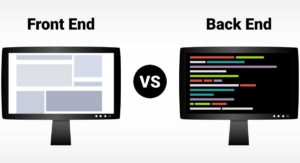A full stack developer is an invaluable asset at any point in time. A full stack developer’s core skill sets cannot be replaced despite all advances in AI.
If you are an aspiring full stack developer, this article is made for you. This comprehensive guide is tailored to give you a clear idea of a full stack web developer roadmap. We’ve got you covered from mastering front-end technologies like HTML, CSS, and JavaScript to diving into back-end systems and databases.
Discover the exciting world of full stack development through our online full stack development program. This guide will walk you through the steps, skills, and insights needed to excel in this dynamic field, ensuring you’re well-equipped for a successful career.
Who is a Full Stack Developer?
A full stack developer is a dynamic professional with expertise in crafting both the front-end (client software) and back-end (server software) components of websites or web applications. This role covers everything from conceptualizing the User Interface to managing databases and servers. They ensure the holistic development of web platforms from inception to deployment.
Also Read: What is Software Testing in Software Engineering?
Key Responsibilities and Skill Set
Collaborating with Design Teams: Full stack developers work with design teams, translating creative concepts into functional and visually appealing web applications.
Optimizing and Debugging: They consistently refine software performance through debugging and thorough testing to ensure seamless user experiences.
Database and Server Creation: Building back-end databases and servers is a pivotal responsibility, facilitating efficient data management and seamless application functionality.
Responsive Design Development: Full stack developers are adept at crafting responsive application designs that function seamlessly across various devices and screen sizes.
Leveraging Advanced Technology: Proficient in utilizing advanced technologies, full stack developers optimize software solutions to deliver robust and efficient applications.
Client Communication: Effective communication with clients is essential for understanding their needs, gathering insights, and aligning the product with their expectations.
Salaries and Career Outlook
The salary for a full-stack developer varies based on location, experience, and the specific industry. In the United States, the average salary for a full-stack developer is $124,919 per year.
Full-stack developers are in high demand in terms of job opportunities. This is because of the trend where people are developing for different platforms at the same time and also because of the increase in cloud computing. A report from LinkedIn in 2020 showed that this job has been growing by 35 percent each year since 2015, and this growth will continue. The Bureau of Labor Statistics says there will be an eight percent increase in jobs for full-stack web developers from 2020 to 2030.
Complete Full Stack Developer Roadmap
Becoming a proficient full stack developer requires a journey through various technological realms. This comprehensive full stack developer roadmap will lead you step by step, equipping you with the essential skills for a successful career in full-stack web development.
Also Read: What is Unit Testing in Python?
Front-end Technology Roadmap for Full-Stack Web Development
This roadmap provides a comprehensive overview of the front-end technologies and tools developers should know.
1. Basics of Web Development
- HTML: Structure of web pages.
- CSS: Styling and layout. Understand the box model, flexbox, grid, selectors, and other fundamentals.
- JavaScript (ES6+): The scripting language of the web. Learn the basics, such as data types, functions, objects, and DOM manipulation.
2. Responsive Design
- Media Queries: Adjusting design based on different screen sizes.
- Mobile-First Design: Crafting experiences with mobile devices as the priority.
- Frameworks: Bootstrap, Tailwind CSS, Foundation, etc., to facilitate responsive design.
3. Version Control/Git
- Understand basic commands: commit, push, pull, branch, merge, etc.
- GitHub/GitLab/Bitbucket: Platforms for hosting and collaborating on code.
4. JavaScript Advanced Concepts
- Asynchronous operations: Promises, async/await.
- ES6+ features: Arrow functions, destructuring, template literals, etc.
- Deep dive into the Event Loop and Callbacks.
5. JavaScript Frameworks/Libraries
- React: Component-based library for building UIs. Dive into hooks, context, Redux for state management, and related technologies.
- Vue.js: Progressive framework for building user interfaces. Understand Vue components, the Vue CLI, and Vuex for state management.
- Angular: A comprehensive front-end framework backed by Google. Explore components, services, and modules.
6. Package Managers
- npm (Node Package Manager): Widely used package manager for JavaScript.
- yarn: Alternative to npm with some enhanced features.
7. Build Tools
- Bundlers: Webpack, Rollup, Parcel.
- Transpilers: Babel (to convert modern ES6+ JavaScript into backward-compatible versions).
- Task Runners: Grunt, Gulp.
8. Web Performance Optimization
- Understand the critical rendering path.
- Learn about lazy loading and asynchronous loading of CSS/JS.
- Webpack bundle analysis.
9. PWA (Progressive Web Apps)
- Service Workers, Cache API, and other technologies for offline-first experiences.
10. CSS Preprocessors & Architecture
- Preprocessors: SASS, LESS.
- Methodologies: BEM, OOCSS, SMACSS.
11. Modern CSS
- CSS-in-JS: Styled-components, Emotion (specifically in the context of JS frameworks).
- CSS Variables.
- Houdini (experimental but represents the future of CSS).
12. Testing & QA
- Unit Testing: Jest, Mocha, Chai.
- End-to-end Testing: Cypress, Puppeteer.
- Integration Testing.
13. Web Accessibility (a11y) & Internationalization
- Ensure web content is accessible to all users, including those with disabilities.
- Tools like Axe and Lighthouse for accessibility audits.
- I18n and L10n strategies for global audiences.
Also Read: Software Development Tutorial: What is Git Merge?
Back-end Technology Roadmap for Full Stack Web Development
Here’s the roadmap for back-end technologies. Remember, the goal isn’t to learn everything on this list but to become familiar with them. Over time, you’ll likely specialize in a subset based on your projects and interests. As with the front-end, the back-end landscape continuously evolves, so staying updated with the latest trends and best practices is essential.
1. Basic Understanding
- Front-end Technologies: Understanding how front-end works can help in building efficient back-ends.
- HTTP/HTTPS and APIs: How client and server communicate.
2. Languages
- JavaScript (Node.js)
Popular frameworks: Express.js, NestJS, Fastify, Koa.js
- Python
Popular frameworks: Django, Flask, FastAPI
- Ruby
Framework: Ruby on Rails
- Java
Frameworks: Spring Boot, Java EE
- Go (Golang)
Frameworks: Gin, Echo
- PHP
Frameworks: Laravel, Symfony, Laminas
- C#
Framework: ASP.NET Core
3. Databases
Relational Databases
- MySQL
- PostgreSQL
- SQLite
- MariaDB
- MS SQL Server
- Oracle
NoSQL Databases
- MongoDB
- Cassandra
- CouchDB
- Firebase Realtime Database
- DynamoDB
Database ORM/ODM
- Sequelize, TypeORM (for JS/TS)
- Hibernate (for Java)
- Entity Framework (for C#)
- Active Record (for Ruby on Rails)
- SQLAlchemy (for Python)
4. Web Servers
- Nginx
- Apache
- Microsoft IIS
5. API (Application Programming Interface)
- RESTful API
- GraphQL
- Apollo Server, Prisma
- SOAP (less common but still used in some legacy systems)
6. Authentication & Authorization
- OAuth
- JWT (JSON Web Tokens)
- OpenID Connect
- Basic Authentication
- Token-based Authentication
7. Caching Strategies
- Redis
- Memcached
8. Messaging and Queue Systems
- RabbitMQ
- Kafka
- Amazon SQS
9. WebSockets
- Socket.io (for Node.js)
- WebSocket API (general)
10. Containerization and Orchestration
- Docker
- Docker Compose
- Kubernetes
- Docker Swarm
11. Web Server Interfaces
- WSGI (Python)
- Rack (Ruby)
- ASGI (Asynchronous Server Gateway Interface for Python)
12. API Documentation and Testing Tools
- Swagger/OpenAPI
- Postman
- GraphQL Playground
13. Cloud Providers and Platforms
- Amazon Web Services (AWS)
- Google Cloud Platform (GCP)
- Microsoft Azure
- Heroku
- DigitalOcean
14. Continuous Integration & Continuous Deployment (CI/CD)
- Jenkins
- Travis CI
- CircleCI
- GitHub Actions
- GitLab CI
15. Testing
- Unit Testing
- Integration Testing
- Functional Testing
Also Read: What Does a Software Engineer Do?
Database System Roadmap
Relational Database Management Systems
- MySQL
- SQLite
- Postgres for structured data storage
NoSQL Databases
- MongoDB
- Cassandra
- Apache Storm:
NewSQL
VoltDB
MemSQL for high-performance relational databases
Additional Skills Recommended for Full-Stack Web Development
Git
Git’s distributed version control capabilities ensure efficient project coordination. It aids in managing and tracking code changes within a repository, with GitHub serving as the dominant repository platform.
Machine Learning
Machine learning’s integration into web development broadens horizons and introduces intelligent features. This subset of AI enhances data processing, user interactions, and application performance.
SSH (Secure Shell Protocol)
SSH guarantees secure remote logins and network services over unsecured networks. Its encryption protocols safeguard privacy and data integrity, fostering secure operations.
HTTP/HTTPS (HyperText Transfer Protocol/Secure)
HTTP and its secured counterpart, HTTPS, dictate web interactions. These protocols guide web servers and browsers in responding to commands, ensuring secure and efficient data transfer.
Linux Command-Line Basics
Familiarity with Linux command-line basics aids in efficient organization and management of back-end elements, saving time and boosting productivity.
Data Structures and Algorithms
Understanding data structures and algorithms enhances efficiency, scalability, and performance. This knowledge influences coding decisions and yields optimized solutions.
.NET and ASP.NET Framework
The .NET framework’s versatility spans both web and server-based applications. ASP.NET, a subset of .NET, simplifies dynamic webpage creation, contributing to a seamless user experience.
Character Encoding
Mastery of character encoding is pivotal for global application development. Proper encoding guarantees readable text display, data processing, and search engine visibility.
Becoming a full-stack developer takes proficiency in many different areas. Investing your resources in the right places can be a fruitful endeavor. For instance, coding bootcamps can help you master the basics of many different coding languages.
Also Read: Web Development Tips: Code Review Best Practices
Top Industries that Hire Full-Stack Developers
Full stack developers are indispensable assets in diverse industries, using their comprehensive skill set to drive innovation and efficiency. Several sectors benefit significantly from their multifaceted expertise.
Computer Software
Full-stack developers thrive in crafting, deploying, and managing software solutions across all layers of the tech stack. Their prowess contributes to enhanced software functionality and user experiences.
Information Technology and Services
Armed with a profound understanding of front-end design and back-end databases, full-stack developers play a pivotal role in shaping seamless user interactions and robust data structures.
Internet
In the dynamic realm of the internet, full-stack developers are constantly pioneering novel techniques to elevate tech stack efficiency, contributing to enhanced user experiences
Financial Services
As low-code and no-code platforms rise, full-stack developers can focus on intricate coding enhancements and innovative solutions within the financial sector, ensuring streamlined operations.
Higher Education
Full-stack developers are catalysts in the evolution of artificial intelligence within the higher education sector. Their contributions facilitate intelligent applications that enhance learning experiences.
Entertainment, Banking, Software, Tech, Travel and Tourism, Government Websites, Education, Insurance, and Transport Services
Full-stack developers are instrumental in diverse sectors. Their cross-disciplinary skills enable holistic contributions across both front-end and back-end aspects.
Get Certified to Become a Fullstack Developer
As you embark on your journey to become a skilled full stack developer, investing in the right education is crucial. You should also be aware of what your goals are and how to get there most effectively. Use your resources and networking to your benefit. Our online full stack development program provides an exceptional opportunity to gain comprehensive knowledge and practical experience. This program covers everything from front-end to back-end development, databases, and additional essential skills. By enrolling, you’re setting yourself up for success in the dynamic world of web development.
You might also like to read:
What is Test-Driven Development, and Why is It Important?
What is White Box Testing? Definition, Types, Features, and Benefits
The 10 Best Software Testing Tools
System Testing in Software Testing: Definition, Types, and Tips






